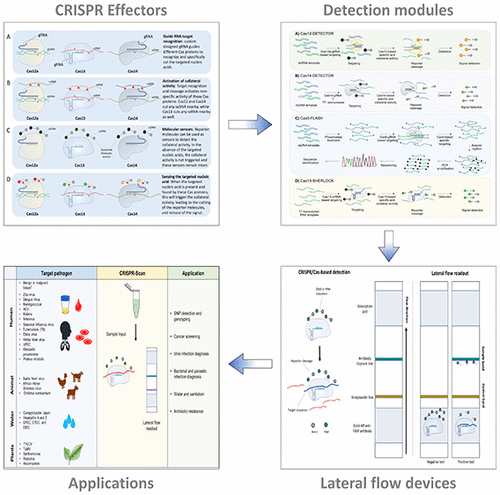当前位置:
X-MOL 学术
›
ACS Synth. Biol.
›
论文详情
Our official English website, www.x-mol.net, welcomes your
feedback! (Note: you will need to create a separate account there.)
Nucleic Acid Detection Using CRISPR/Cas Biosensing Technologies.
ACS Synthetic Biology ( IF 3.7 ) Pub Date : 2020-03-11 , DOI: 10.1021/acssynbio.9b00507 Rashid Aman 1 , Ahmed Mahas 1 , Magdy Mahfouz 1
ACS Synthetic Biology ( IF 3.7 ) Pub Date : 2020-03-11 , DOI: 10.1021/acssynbio.9b00507 Rashid Aman 1 , Ahmed Mahas 1 , Magdy Mahfouz 1
Affiliation

|
For infectious diseases, rapid and accurate identification of the pathogen is critical for effective management and treatment, but diagnosis remains challenging, particularly in resource-limited areas. Methods that accurately detect pathogen nucleic acids can provide robust, accurate, rapid, and ultrasensitive technologies for point-of-care diagnosis of pathogens, and thus yield information that is invaluable for disease management and treatment. Several technologies, mostly PCR-based, have been employed for pathogen detection; however, these require expensive reagents and equipment, and skilled personnel. CRISPR/Cas systems have been used for genome editing, based on their ability to accurately recognize and cleave specific DNA and RNA sequences. Moreover, following recognition of the target sequence, certain CRISPR/Cas systems including orthologues of Cas13, Cas12a, and Cas14 exhibit collateral nonspecific catalytic activities that can be employed for nucleic acid detection, for example by degradation of a labeled nucleic acid to produce a fluorescent signal. CRISPR/Cas systems are amenable to multiplexing, thereby enabling a single diagnostic test to identify multiple targets down to attomolar (10–18 mol/L) concentrations of target molecules. Developing devices that couple CRISPR/Cas with lateral flow systems may allow inexpensive, accurate, highly sensitive, in-field deployable diagnostics. These sensors have myriad applications, from human health to agriculture. In this review, we discuss the recent advances in the field of CRISPR-based biosensing technologies and highlight insights of their potential use in a myriad of applications.
中文翻译:

使用 CRISPR/Cas 生物传感技术进行核酸检测。
对于传染病,快速、准确地识别病原体对于有效管理和治疗至关重要,但诊断仍然具有挑战性,特别是在资源有限的地区。准确检测病原体核酸的方法可以为病原体的即时诊断提供稳健、准确、快速和超灵敏的技术,从而产生对疾病管理和治疗非常有价值的信息。多种技术(主要是基于 PCR 的技术)已用于病原体检测;然而,这些需要昂贵的试剂和设备以及熟练的人员。 CRISPR/Cas 系统因其准确识别和切割特定 DNA 和 RNA 序列的能力而被用于基因组编辑。此外,在识别靶序列后,某些 CRISPR/Cas 系统(包括 Cas13、Cas12a 和 Cas14 的直系同源物)表现出可用于核酸检测的附带非特异性催化活性,例如通过降解标记的核酸以产生荧光信号。 CRISPR/Cas 系统适合多重分析,从而使单个诊断测试能够识别低至阿摩尔 (10 –18 mol/L) 浓度的目标分子的多个目标。开发将 CRISPR/Cas 与侧流系统结合的设备可能会实现廉价、准确、高灵敏度、现场可部署的诊断。这些传感器具有从人类健康到农业的无数应用。在这篇综述中,我们讨论了基于 CRISPR 的生物传感技术领域的最新进展,并重点介绍了它们在众多应用中的潜在用途。
更新日期:2020-03-11
中文翻译:

使用 CRISPR/Cas 生物传感技术进行核酸检测。
对于传染病,快速、准确地识别病原体对于有效管理和治疗至关重要,但诊断仍然具有挑战性,特别是在资源有限的地区。准确检测病原体核酸的方法可以为病原体的即时诊断提供稳健、准确、快速和超灵敏的技术,从而产生对疾病管理和治疗非常有价值的信息。多种技术(主要是基于 PCR 的技术)已用于病原体检测;然而,这些需要昂贵的试剂和设备以及熟练的人员。 CRISPR/Cas 系统因其准确识别和切割特定 DNA 和 RNA 序列的能力而被用于基因组编辑。此外,在识别靶序列后,某些 CRISPR/Cas 系统(包括 Cas13、Cas12a 和 Cas14 的直系同源物)表现出可用于核酸检测的附带非特异性催化活性,例如通过降解标记的核酸以产生荧光信号。 CRISPR/Cas 系统适合多重分析,从而使单个诊断测试能够识别低至阿摩尔 (10 –18 mol/L) 浓度的目标分子的多个目标。开发将 CRISPR/Cas 与侧流系统结合的设备可能会实现廉价、准确、高灵敏度、现场可部署的诊断。这些传感器具有从人类健康到农业的无数应用。在这篇综述中,我们讨论了基于 CRISPR 的生物传感技术领域的最新进展,并重点介绍了它们在众多应用中的潜在用途。











































 京公网安备 11010802027423号
京公网安备 11010802027423号